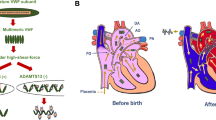Summary
During the last thirty years, the diagnosis, management and prevention of haemolytic disease of the newborn infant (HDN) have improved. From 1959 to 1988, 3004 HDN (ABO excluded) have been collected. The percentage of HDN with anti-D alloimmunization decreased significantly (98.4% from 1959 to 1968, 93.5% from 1969 to 1978 and 68.1% from 1979 to 1988). The anti-D HDN with exchange transfusion (ET) fell significantly between the first and second periods (577 versus 970;X 2=19.92;P<0.001). On the other hand, the number of HDN other than anti-D increased during these three periods, but the percentage of these HDN which needed ET decreased. Our study shows the long term efficiency of the prevention of anti-D alloimmunization (since 1970) and of the irregular antibodies screening among all pregnant women (since 1979).
Similar content being viewed by others
References
American Association of Blood Bank (1977) Technical manual, 7th ed. Washington
Bennebroeck Gravenhorst J (1988) Management of serious alloimmunization in pregnancy. Vox Sang 55:1–8
Bowman JM (1978) The management of Rh-isoimmunization. Obstet Gynecol 52:1–16
Clarke CA, Donohoe WTA, Mc Connel RB, Woodrow JC, Finn R, Krevans JR, Kulke W, Lehane D, Sheppard PM (1963) Further experimental studies on the prevention of Rh haemolytic disease. Br Med J 1:979–984
Clarke CA, Mollison PL, Whitfield AGW (1985) Deaths from rhesus haemolytic disease in England and Wales in 1982 and 1983. Br Med J 291:17–19
Finn R, Clarke CA, Donohoe WTA, Mc Connell RB, Sheppard PM, Lehane D, Kulke W (1961). Experimental studies on the prevention of Rh haemolytic disease. Br Med J 1:1486–1490
Freda VJ, Gorman JG, Pollack W (1964) Successful prevention of experimental Rh sensitization in man with an anti-Rh gamma2-globulin antibody preparation: a preliminary report. Transfusion 4:26–32
Levine P, Stetson RE (1939) An unusual case of intra-group agglutination. JAMA 113:126–127
Liley AW (1961) Liquor amnii analysis in the management of the pregnancy complicated by rhesus sensitization. Am J Obstet Gynecol 82:1359–1370
Pepperell RJ, Barrie JV, Fliegner JR (1977) Significance of red cell irregular antibodies in the obstetric patient. Med J Aust 2:453–456
Woodrow JC, Donohoe WTA (1968) Rh-immunization by pregnancy: results of a survey and their relevance to prophylactic therapy. Br Med J 4:139–144
Author information
Authors and Affiliations
Rights and permissions
About this article
Cite this article
Moncharmont, P., Dupraz, F.J., Vignal, M. et al. Haemolytic disease of the newborn infant. Long term efficiency of the screening and the prevention of alloimmunization in the mother: thirty years of experience. Arch Gynecol Obstet 248, 175–180 (1991). https://doi.org/10.1007/BF02390356
Received:
Accepted:
Issue Date:
DOI: https://doi.org/10.1007/BF02390356




